‘Behind the 8-ball:’ Many Southern California nursing homes hit hard by coronavirus had prior issues
This story was produced as part of a larger project by Brenda Gazzar, a participant in the 2020 California Fellowship.
Her other stories include:
'This isn't a drill': How LA's Motion Picture home battled coronavirus
‘Pandemic within a pandemic:’ What’s fueling LA County’s coronavirus death toll in nursing homes?
Known and loved: These six residents of LA’s Motion Picture home died of coronavirus
A tale of two Southern California nursing homes in the era of coronavirus
Family of nursing home resident who died: ‘She had 3 really good years there and 1 really bad week’
Social isolation takes toll on Southern California nursing home residents during pandemic holidays
Can California nursing homes avoid the next ‘humanitarian crisis?’
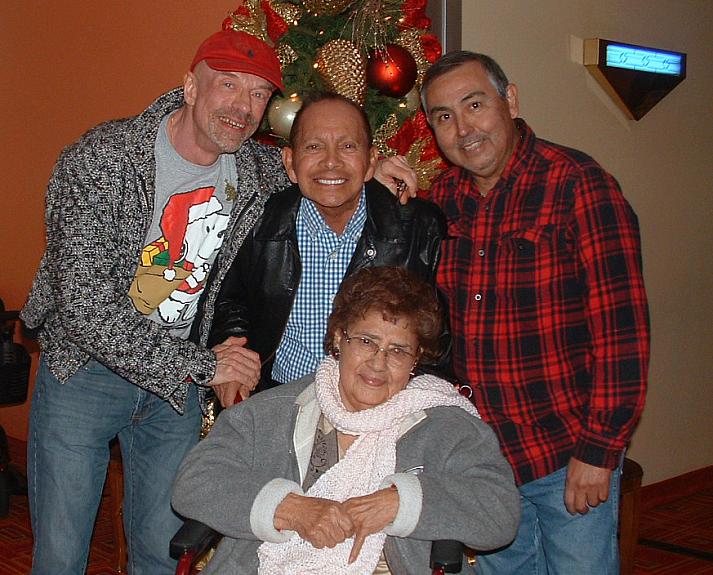
Ed Harbur, Dave Gonzalez and Gustavo “Sky” Gonzalez with the Gonzalez’s mother, Evangelina. Evangelina became infected with COVID-19 in April, although she remained asymptomatic. But she was isolated for everyone’s safety, confusing and scaring 98-year-old Gonzalez, who has Alzheimer’s disease
(Photo courtesy of Sky Gonzalez)
Evangelina Gonzalez survived the coronavirus. But she found herself lonely and confused inside her nursing home.
The 98-year-old, who has dementia, had fallen a couple of times at Monterey Palms Health Care Center in the Coachella Valley, her son said. After contracting the virus last spring, she was placed in an isolation wing for six weeks.
“I’ll try to call her and she’s just like, ‘Where are you, where are you? I’m hungry, I’m thirsty, I’m in pain,’” said Gustavo “Sky” Gonzalez of Cathedral City. “It’s heartbreaking.”
Even before the pandemic, Monterey Palms seemed to have high turnover and other staffing issues, he said.
“They were so short that administrators were manning the front desk, helping with maintenance and during the week couldn’t even get anyone at the facility to answer the phones,” Gustavo Gonzalez said.
As of Sept. 11, 18 patients died of COVID-19 at Monterey Palms, a home that had an average of 91 daily residents before the pandemic. That’s roughly a 20% death rate among its residents, though the actual percentage could be higher, according to an analysis of data from Medicare’s Nursing Home Compare database and the California Department of Public Health’s Skilled Nursing Homes COVID-19 database.
The home was one of the hardest hit nursing homes for its population in the Inland Empire and the region. At some facilities in the Los Angeles area, roughly 30% of their residents experienced a COVID-related death.
According to Linda Taetz, president of the Monterey Palms Operating Co. and the compliance officer of the larger chain, Mariner Healthcare, that owns the facility, it’s something of a mystery why some facilities are harder hit than others.
“We just don’t know why,” said Taetz, a registered nurse.
Her company owns 20 facilities in California and has a daily COVID-19 conference call with leadership at each facility.
“We go over everyone’s information. Where was PPE needed? Where was additional staff?” she said. “In other words, we shared everyone else’s best practices.”
Staffing
Monterey Palms had a three-star or average staffing rating on the Nursing Home Compare five-star rating system before the pandemic.
Most of the hardest hit homes in the region, as to resident deaths for their average daily population, had a below-average rating on staffing, according to a Southern California News Group review of such facilities in Los Angeles, Orange, Riverside and San Bernardino counties. (Homes designated to receive COVID patients were excluded.)
Staffing shortages have been made even worse by the dangers posed by having staff working in multiple facilities, which had been a common practice before the pandemic.
“The state frowns on saying you absolutely cannot” work in more than one facility, Taetz said. “We do discourage it, to be honest.”
Many factors can contribute to how severely the virus strikes a nursing home, including its location and size. But having enough staff is vital, especially during a pandemic, experts say. New research backs that up.
California nursing homes with total registered nurse staffing levels beneath the recommended minimum standard — 45 minutes per resident a day — before the pandemic were twice as likely to have COVID-19 resident infections, according to a study published in July in Sage Journals.
Monterey Palms residents received an average of 18 minutes with a registered nurse per day compared to the state average of 38 minutes and the national average of 41 minutes, according to Nursing Home Compare.
“The (registered nurses) are crucial because they are the ones who do the infection control planning. They know how to wear PPE (personal protective equipment) and isolate residents and assess the residents to tell if they have infections,” said the study’s lead author, Charlene Harrington, a professor emerita at UC San Francisco and a registered nurse by training.
Nursing homes with lower Medicare five-star ratings on total nurse staffing levels, higher total health deficiencies and more beds also had a higher probability, the study found.
Another study found that every 20-minute increase in RN staffing predicted a 26% reduction in COVID deaths in Connecticut nursing homes with at least one death, according to the Journal of American Geriatrics Society.
Scant staffing, largely due to low pay and the difficulty of the work, has taken a harsh toll on local nursing home residents for years, advocates say. That’s especially true now.
Molly Davies, vice president of Elder Abuse Prevention and Ombudsman Services, is photographed at her WISE & Healthy Aging office in Santa Monica on Tuesday, August 26, 2020.(Photo by Axel Koester, Contributing Photographer)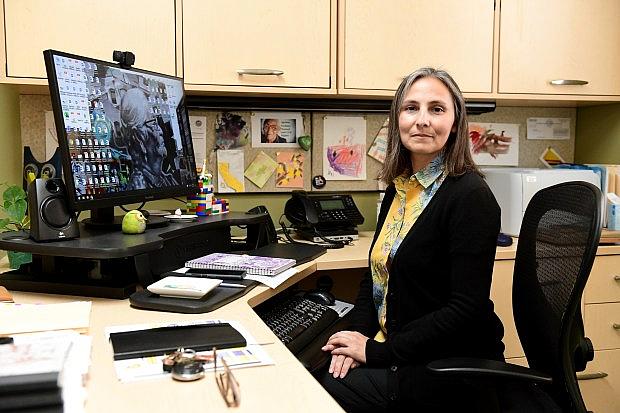
“If you have a resident who is in distress and who has fallen, your instinct is to go and help that person. But maybe you haven’t washed your hands,” said Molly Davies, who oversees the long-term care ombudsman program in Los Angeles County that investigates and tries to resolve complaints of such residents. “If you have additional staffing, those kinds of errors are going to happen less frequently.”
Davies’ WISE & Healthy Aging office has received calls recently about residents not being bathed and phones unanswered due to a lack of staff, she said.
As of Sept. 11, Bell Convalescent Hospital had 27 resident deaths related to COVID, according to state data. It has a capacity of 95 residents.
The home did not have a staffing rating available on Nursing Home Compare due to insufficient or unverifiable staffing data submitted, according to the Medicare database. The home did not respond to requests for comment.
The Council on Aging’s Libby Anderson, the long-term care ombudswoman in Orange County, echoed concerns about lower than usual staffing in the coronavirus era.
“We hear from a lot of worried families: ‘My loved one is not getting attention, the call light is not being answered, they’re not being changed, they’re not being showered,’” she said. “We’re really worried about what kind of declines we’re going to see in our residents.”
Ombudsmen like Anderson are restricted in visiting nursing homes due to the pandemic so they don’t know the full extent of the residents’ problems, she said.
California upped the number of direct care hours required for each nursing home resident in 2018. But the law allows facilities to get waivers based on patient needs or health care worker shortages — and many of them do.
Amanda Steele, 35, is the deputy policy director of Service Employees International Union Local 2015, which represents nursing home, assisted living center and home care workers throughout California, shown here outside her home in Monrovia on Friday, Aug. 28, 2020. (Photo by Trevor Stamp, Contributing Photographer)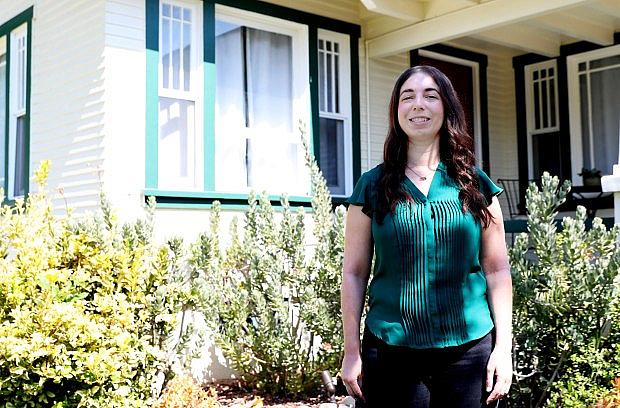
The staffing waivers were not meant to be permanent; they’re only a tool to ensure facilities had time to transition to the new staffing levels, said Amanda Steele, deputy policy director of Service Employees International Union Local 2015, which represents home care and nursing home workers.
“At this point, we’d really like to see those waivers gone,” Steele said. “We want every facility to … abide by the bare minimum (staffing requirements).”
The Center for Medicare & Medicaid Services (CMS) and the state also have waived certain staffing requirements during the COVID-19 crisis.
The California Department of Public Health said via email that “not all” waiver requests made to the state are accepted. But advocates contend it further endangers residents.
“Holding nursing homes to a higher staffing ratio would be necessary right now and nobody is holding anyone to that standard,” Davies, the Los Angeles ombudswoman, said.
A woman passes Brighton Care Center in Pasadena on Wednesday, April 22, 2020 during the coronavirus pandemic. The skilled nursing facility has a COVID-19 outbreak according to the California Department of Public Health. (Photo by Sarah Reingewirtz, Pasadena Star-News/SCNG)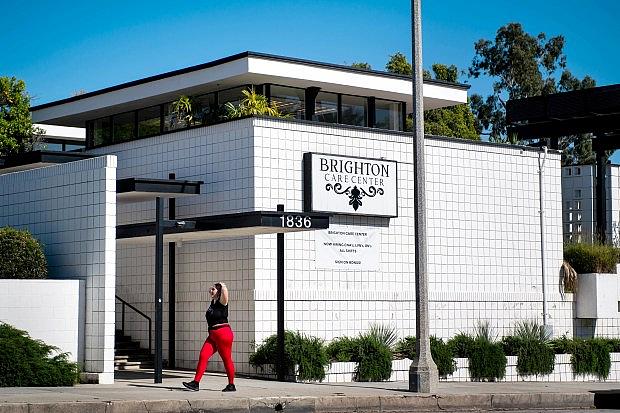
Infection control
At Brighton Care Center in Pasadena, a licensed vocational nurse removed her protective N95 mask while performing CPR on a resident with COVID-19. The move, documented by state surveyors in May, violated city, state and federal infection control protocols.
“This deficient practice had the potential for the spread of novel coronavirus 2019 … through respiratory inhalation,” the California Department of Public Health found.
Brighton has been cited every year since 2017 for infection control issues. Like many nursing homes in the region, it also had a below average rating for health inspections. The nursing home did not respond to requests for comment. The vast majority of the home’s 85 average daily residents contracted the virus at some point, according to state data. Sixteen of them died.
In August 2019, a nursing assistant at the home failed to wear personal protective equipment while entering an isolation room of a resident with an unspecified infection, according to CMS records. A visitor also entered the room without wearing the appropriate PPE.
Most nursing homes have six to seven health deficiencies per inspection, according to CMS. Infection control deficiencies are not uncommon and several hard-hit facilities in the region have been cited for them before and during the pandemic.
“Nursing homes are health facilities. They should have been able to manage this better than they have,” Davies, the Los Angeles ombudswoman, said.
Had state and L.A. County public health officials ensured nursing homes had been meeting minimum standards all along, these vulnerable residents would have been “far better off,” she said.
“But now they’re having to start from a place of not having good infection control practices, which they should already have. They’re starting from a place where they have poor staffing levels, a constant issue, and some facilities not having supplies that they need. … They are way behind the 8-ball because of that.”
Dr. Noah Marco, chief medical officer for the Los Angeles Jewish Home, argues that the process to evaluate nursing home quality is problematic.
“(It’s) did everybody do the right thing at every moment while (surveyors were) in the building versus do you have good systems and processes and are you watching your people and systems and processes?” Marco said.
The Los Angeles County Board of Supervisors appointed a watchdog in June to improve accountability and oversight of skilled nursing homes in its jurisdiction and to help tackle a backlog of thousands of complaints dating back years. The L.A. County Department of Public Health has oversight authority over most of the nursing homes in the county.
Besides COVID-related issues, watchdog Max Huntsman, who also oversees the county’s sherrif’s and probation departments, said he and his team are looking at how to ensure nursing homes, which largely get reimbursed from Medicaid and Medicare, have the resources to do their job well. It’s also about having an adequate system of checks and balances.
“What is the enforcement mechanism that gets people’s attention?” he said. “You can issue fines but they better be big… whereas a police department that can make an elder abuse case can put someone in jail.”
Meanwhile, the state’s Department of Public Health has required all skilled nursing facilities to create a plan to reduce COVID infections, which must include having a full-time infection control preventionist. Nursing homes had to submit the plan by the end of June — five months after the state’s first COVID case.
Rooms packed with residents
A federal rule requires nursing home rooms with more than one resident to have at least 80 square feet of usable living space per person.
Several homes hard hit by COVID, particularly in L.A. County, fell short of this room space requirement in recent years, according to this newsgroup’s review. CMS and the state have also waived room space requirements during the pandemic.
West Valley Post Acute in West Hills on Thursday, September 3, 2020. (Photo by Dean Musgrove, Los Angeles Daily News/SCNG)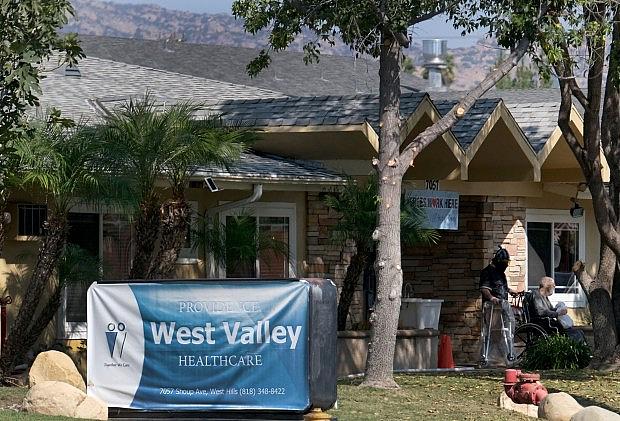
West Valley Post Acute nursing home in L.A.’s West Hills community was cited by state surveyors early this year for violating the rule. A 220-square-foot bedroom had been used by three residents in February, according to state deficiency records.
The 128-bed home requested and received room size waivers in recent years for dozens of rooms in order to use “all of the facility’s licensed beds,” said Dan Kramer, a spokesman for the home, by email.
After a staff member tested positive in mid-April, two dozen residents and a staff member ultimately died of COVID-related causes, Kramer said.
When asked whether the smaller room sizes could have contributed to the virus’ spread, Kramer said the amount waived was “not believed to be significant enough” to have a negative impact. The waivers were for less than two square feet per resident.
But advocates are concerned about a lack of space in these facilities, many of which were built decades ago.
“I think it is really important, clearly more so now,” said Steele of SEIU Local 2015.
Harrington, the emerita professor at UC San Francisco, agreed.
“If you have two and three patients all scrunched up in one room using the same bathroom, you can’t isolate them,” she said. “It really helps if you can move someone who gets the virus to a single room.”
Nursing homes should adopt the same COVID-era guidelines used elsewhere in the community, Davies, the L.A. ombudswoman, said. Doctors’ offices, for example, mark certain chairs with red tape to show they are off limits.
Doing that with beds in nursing homes, however, would be “to try to eliminate a money-making space in the facility,” Davies added. “You can have a fight from the industry.”
The state Department of Public Health reviews the room size waiver requests and makes room by room recommendations to CMS “based on the adequacy of the request,” the agency said by email.
In light of the pandemic, the city of Los Angeles is now looking at whether improvements can be made to the design and layout of nursing homes in the future “to make them more resilient,” a spokeswoman for Mayor Eric Garcetti said.
Testing a big challenge
Several hard-hit nursing homes cited testing issues as one of their biggest challenges.
Initially “we were told and advised that due to shortages, we should only be testing those individuals with active symptoms,” Kramer, the spokesman for West Valley Post Acute, said by email.
Once tests were administered, he said, lab companies “were overwhelmed with requests to process kits and often took somewhere between 10 to 14 days to process a result.”
The coronavirus crisis in nursing homes “really boils down to asymptomatic workers and testing,” said Deborah Pacyna of the California Association of Health Facilities. If employees are being tested every week, they may not get results back now for three days.
“You may have that lag time where you may have the infection in your facility and don’t even know it,” she said.
Mariner Healthcare began by testing a quarter of its staff every week, with results coming back in about 48 hours. But testing was ramped up for facilities with a high rate of infection or when the communities they were located in had high rates of infection, according to Taetz.
The company has new testing equipment provided by the federal government that staff is now being trained to use, which will make getting testing results even quicker.
Some nursing homes cited the size of their facility — larger homes have more traffic — and demographics as possible contributing factors.
Amber Gooden of View Park Convalescent Hospital in Los Angeles, Wednesday, August 26, 2020. (Photo by Hans Gutknecht, Los Angeles Daily News/SCNG)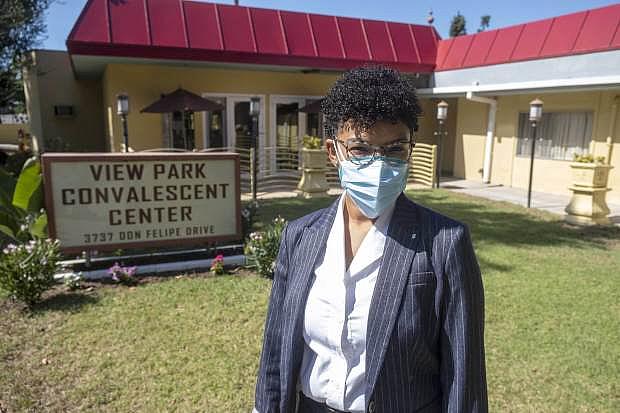
At View Park Convalescent Hospital in South L.A.’s Baldwin Hills, residents average 75 years of age with more than 40% of their residents over the age of 80, according to Amber Gooden, the home’s administrator. The home lost about 20 residents to COVID, according to the state, and had a daily average of 93 residents before the pandemic.
“The residents we care for are compromised,” Gooden said.
The vast majority of their residents are also Black and, thus, more likely to have chronic health conditions, she said.
Homes with a lower percentage of white residents are more likely to have higher COVID cases and deaths, studies have found. Counties that have been hard hit by the virus, like L.A. County, also are more likely to have hard-hit nursing homes.
Still, advocates argue that nursing homes have significant control over their fate.
“In good facilities, they are treating every staff member and resident as if they have (the virus),” said Tony Chicotel, staff attorney at California Advocates for Nursing Home Reform. “They are loading up on PPE and doing a lot of testing. The facilities that are not doing such a great job are not acting that way.”
Meanwhile, the Monterey Palms home in the Coachella Valley remains on lockdown. And Gustavo Gonzalez feels helpless.
“They always say, ‘If you’re not happy with our services, you’re always welcome to pick her up and take her home,’ ” he said. “But I don’t have the physical or financial wherewithal to do that.”
So his mother, Evangelina Gonzalez, remains inside.
“My only prayer is that, because of dementia, she’s not too conscious of what she’s going through,” her son said.
Taetz understands the frustration of family members.
“It is not our desire to keep them apart,” she said. “It makes it terrible for the residents and very challenging for our staff.”
Contributor Elissa Lee contributed to this report. This article was produced as a project for the USC Center for Health Journalism’s California Fellowship.
[This story was originally published by Los Angeles Daily News.]


